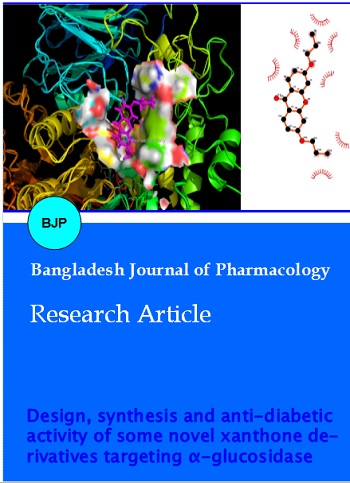Design, synthesis and anti-diabetic activity of some novel xanthone derivatives targeting alpha-glucosidase
DOI:
https://doi.org/10.3329/bjp.v11i2.25851Keywords:
Anti-diabetic, Design, Synthesis, Xanthone derivative, ?-GlucosidaseAbstract
Twenty eight xanthone derivatives were designed and docked into the N-terminal catalytic domain of maltase-glucoamylase (ntMGAM) by considering Miglitol as standard drug. Most of the molecules showed excellent docking scores and docking interaction as compared to the binding cavity of the standard molecule. The five best scoring ligands were synthesized and characterized by a number of analytical and spectroscopic techniques. The molecules were screened for the in vivo antidiabetic activity in streptozotocin (STZ) induced diabetic animal model in Wistar rats. Compound P4 showed the most prominent inhibition among others. The synthesized compounds reported significant (p< 0.01) effect of lowering glucose levels in the blood compared to miglitol as a standard alpha-glucosidase inhibitor.
Video Clips of Methodology:
Synthesis of hydroxyxanthones: 7 min 2 sec Click to watch
Induction of diabetes: 1 min 39 sec Click to watch
Downloads
616
418 Read
278

Published
How to Cite
Issue
Section
License
Authors who publish with this journal agree to the following terms:
- Authors retain copyright and grant the journal right of first publication with the work simultaneously licensed under a Creative Commons Attribution License that allows others to share the work with an acknowledgement of the work's authorship and initial publication in this journal.
- Authors are able to enter into separate, additional contractual arrangements for the non-exclusive distribution of the journal's published version of the work (e.g., post it to an institutional repository or publish it in a book), with an acknowledgement of its initial publication in this journal.
- Authors are permitted and encouraged to post their work online (e.g., in institutional repositories or on their website) prior to and during the submission process, as it can lead to productive exchanges, as well as earlier and greater citation of published work (See The Effect of Open Access).
